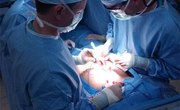A cardiologist is a specialist with expertise in diagnosing and treating cardiovascular and blood vessel diseases and conditions such as angina, atherosclerosis, arrhythmia and heart valve problems among others. Cardiologists also play a critical role in preventing heart diseases by advising patients to adopt a healthy lifestyle through such things as exercising and quitting smoking. Cardiologists must undergo several years of thorough training.
Bachelor’s Degree
The first step toward becoming a cardiologist is acquiring a four-year bachelor’s degree in premedical courses. According to University of Minnesota, courses such as parasitology, zoology, genetics and botany satisfy this requirement because they involve both classroom coursework and laboratory practice. At the University of Minnesota, prospective cardiologists also need to take biology, which covers physiology, general principles and cell biology for one year. Courses in chemistry consisting of one year of organic chemistry and biochemistry classes are also required along with one year of physics classes in calculus or trigonometry.
Medical Degree
After earning a bachelor’s degree, students can enroll either for a Doctor of Osteopathic Medicine or Medical Doctor degree upon entering medical school. Both of these degrees will take four years to complete. The first two years in medical school consist of classroom coursework and laboratory practice that cover courses such as physiology and histology. Students learn about human anatomy by dissecting a cadaver in the laboratory.
At the University of Pennsylvania, they also spend time in pharmacology classes learning the effect of drugs on the body and disease processes, their interactions and side effects. Medical students at Stanford University will spend weeks in microbiological classes learning about various microbes and microbial life. To gain hands-on experience during their third and fourth years in medical school, they go for clinical rotations in most medical specialties under the supervision of an experienced physician. Upon graduating, students must pass the licensure exam to practice medicine in the United States and its territories.
Residency Training
After medical school, the prospective cardiologist enrolls for residency in internal medicine, which usually takes three years to complete. Residency involves clinical rotations in various internal medicine fields such as cardiology, gastroenterology, oncology and endocrinology. Most programs require a research project during the residency, which will help residents in applying for fellowship. Residency training integrates both research and clinical activities that help students become competent physicians.
Cardiology Fellowship
The final step is undertaking a three-to-four year cardiology fellowship. During this period, the focus is on the core area of specialization: cardiology. According to Georgetown University, doctors split their time between making cardiology rotations to gain clinical knowledge and carrying on research in various aspects in their field. Fellowship training entails managing various cardiac patients under the supervision of experienced physicians.
Related Articles
References
Writer Bio
Maria OCadiz has been writing professionally since 1982, most recently publishing for various websites on topics like health and wellness, and education. She holds a Master of Arts in Education. She is a former university professor, curriculum facilitator and teacher.











